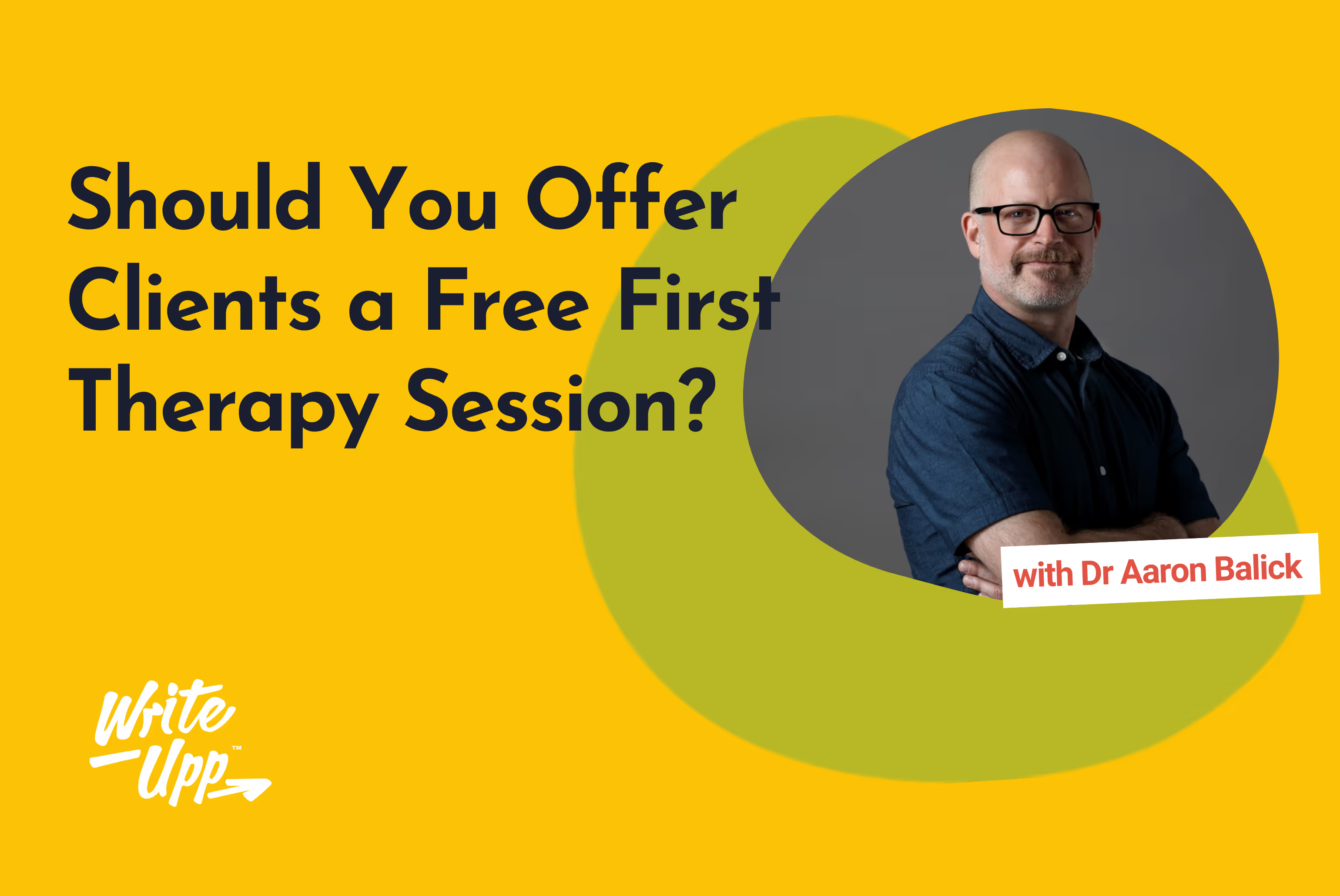A good note-taking system can be difficult to find – and even the best therapists struggle with it.
Often, practitioners only take the minimum amount of notes required by law (or by insurance companies).
But great notes can do a lot more than protect you from liability:
They can actually make you a more effective therapist.
How?
First of all, you're more likely to remember details between sessions. It builds trust and rapport with your new clients, as evidence that you're really listening to them when you recall past sessions.
Having clear and concise notes can help clinicians communicate more effectively.
And let's not forget that progress notes are legal documents.
Knowing how to write clear, accurate, and easily digestible progress notes is crucial to a healthcare professional’s career.
Why are Progress Notes so Important?
There are a few reasons why progress notes are essential in your clinical practice:
- Writing progress notes after each session and storing them in a GDPR-compliant system is essential for the safety and protection of your clients – and yourself – in the event of an emergency or litigation. If you haven’t recorded it, it didn't happen!
- Progress notes allow health professionals to communicate easily with one another. Before the next session, progress notes provide practitioners with information on what happened during the previous session; regardless if it was you or another clinician who treated the patient. They also serve as a refresher for clinicians who have a lot of cases and might struggle to remember details from the last therapy session.
- Clients and healthcare practitioners will often use progress notes as a contract.
The client and the clinician need to be able to track the progress of treatment goals and the overall treatment plan, and they’ll be able to do this with the aid of well written therapy notes.
Progress Notes Templates
Example of an individual progress note written using the SOAP format:
Date of session: 03/07/2023
Time of session: 10:03 am
Patient name: Alexander Jones
Subjective: Alexander is currently "feeling better". He has been making sure to get 7-8 hours of sleep each night and has been exercising 1-2 times a week. Additionally, he has been diligent in taking his medication as prescribed and has been actively practising positive self-talk instead of negative. As a result, his feelings of worthlessness have decreased.
Objective: During Alexander's recent session, it was noted that he has experienced a decrease in anxiety and mild depressive symptoms. His medication compliance is good, and he has actively incorporated stress-relieving techniques into his daily routine. Furthermore, his overall demeanour has improved since his last session, as he displays increased attentiveness and engagement.
Assessment: Alexander is responding well to his treatment. He's actively searching for effective ways to alleviate his anxiety and is implementing them in his daily routine. Additionally, his adherence to medication is contributing to the improvement of his anxiety symptoms.
Plan: Alexander is to continue with his current medication dosage. Meetings will continue weekly.
Example of an individualised group therapy progress note:
Date of session: 10/07/2023
Time of session: 4:35 pm
Patient name: Karen Smith
Group topic: During the session, the focus was on maintaining sobriety and preventing drug use. The group members were asked to share any recent changes in their lives, and they talked about their struggles with cravings. They also exchanged ideas on coping mechanisms to avoid relapsing.
Interventions by group leader: During the group discussion, I moderated and ensured that all members had equal opportunities to speak. I redirected the conversation from any topics that might trigger negative emotions and encouraged everyone to be honest and open. Additionally, I provided support in establishing healthy boundaries and identifying effective coping mechanisms.
Individual participant’s behaviour: Karen's demeanour was quite subdued throughout the session. Her contributions were limited to only a couple of instances, and she refrained from sharing any details regarding her personal life. Although Karen did admit to having cravings, she denied any use of drugs.
5 Steps for Writing Better Progress Notes
The best way to write effective and reliable therapy notes is to use a template, either created by yourself or using one from a good practice management system.
Using a template means you won't miss anything, and you’ll be prompted to record only what you really need to.
There’s always more you can do though!
Let’s take a look at the 5 steps you should take to start writing next-level therapy notes:
- Use the SOAP method
SOAP is used to help clinicians document the critical points within a therapy session.
The acronym stands for:
Subjective
Objective
Assessment
Plan
Using this method, you can stay clear and concise by focusing on the most important information:
- Subjective
Subjective experiences and feelings are unique to each patient.
The information recorded here could include their perception of progress, things they feel they have achieved or made progress in, and places where they are struggling or need more support.
This is also a place to ask about the client's goals and desires.
- Objective
Objectives are statements of fact and/or information gained from subjective experiences.
The purpose of this section is to describe what occurred during the therapy session, and keep it factual.
Consider including observations of your client's attitude, affect, and response.
Including a physical examination and vital signs is also a great idea, if appropriate.
Bear in mind that counsellors and psychotherapists are required to write factual and concise notes with no personal opinion in them.
- Assessment
In the Assessment section, both subjective and objective items should be considered.
You should then note down your clinical impression and professional opinion about the client's progress.
- Plan
Finally, the three pieces above come together to inform a Plan.
This plan should include any treatment provided during the session, its justification, the patient's response, next steps and appointments, follow-up instructions, goals, and outcome measurements.
You could add the following questions to your template:
- When are you going to see the client again?
- During that time, what are their plans?
- Are safety plans necessary?
- Have their goals changed?
For each problem or condition, note actionable items. The goal is ultimately to address each item.
- Be specific and concise
A therapy note should be concise, but contain enough information to explain what happened during the session.
It's easy to forget the details about a client's last session within a month or two, even if you remember every detail at the time.
To help you recall or provide a clear picture of your client's mental health history, you should take notes that are specific and detailed, and that stick to the facts.
Stay away from shorthand, jargon, and your own unique acronyms - stick to commonly used terms and grammar.
All members of your team should be able to understand your notes and, as a result, help the patient recover more effectively.
Once you become a pro at this, you'll create concise notes that are quick to write and easy to digest.
We recommend using a template such as SOAP notes (see step 1) to ensure you get all the information you need and to help other practitioners find the information they want.
- Prioritise Your Notes
No one becomes a health care practitioner to write notes.
But however tempting it is to ignore the note-taking part of your role when you are short of time; don’t.
You must prioritise professional note taking after every session for these reasons:
- Safety of clients - keeping the rest of the team informed
- In the event your competence comes into question, you will have legal documentation of your actions
- You may not be able to recall details from a previous session or goals the client wanted to achieve if you don't keep notes. The relationship you have built with each client will suffer if you ask them to retell details or forget their goals.
- Avoiding writing client notes will only mean that you will have to do so at a later date, and this will only build up to an unmanageable job.
Including social details like what job they have, or family information like if they have children or grandchildren builds better relationships with clients and makes them feel like you value them.
Likewise, including their mobility status in notes means you can offer appropriate support if required (e.g. is the client a wheelchair user?).
Perhaps your client takes time in the morning to get moving due to health issues or comorbidities -- you can offer them an afternoon appointment to accommodate this. They will appreciate this and feel really valued!
Top Tip: try using voice transcription, which means no typing. You can get your notes out of your head and into your private practice software easily.
- Monitor client progress & adjust accordingly
The notes you keep on your patients will allow you to understand the progress they are making. As their progress changes, your plan will need to be adjusted.
Keep an eye on progress (or lack thereof) to determine if you need to adjust and then document the adjustments accordingly.
Therapy notes are a critical component of a successful recovery, and documenting sessions in a thorough and efficient way will only benefit you and your team.
- Use a template
It's best practice to use a well-crafted template when writing therapy notes.
It means you won't forget anything, and you'll be prompted to record what you really need.
You can save templates for common conditions that you treat on a regular basis; for example a template for acute plantar fasciopathy advice and exercises.
Plus: it keeps all your notes consistent, and consistent with other clinicians in your practice.
Clinic management software like WriteUpp is tailor-made for healthcare professionals and comes with all the note and assessment templates you need to follow the steps above and write better therapy progress notes.
Using software like this will mean you can write and access your therapy notes from anywhere, using any device.
It’s also GDPR compliant and ISO27001 registered, so you can rest easy knowing your notes are stored safely.
Sign up for a free trial and you’ll have access to the entire library of templates, as well as a whole host of time saving features to allow you to provide better care for your clients.
Got questions about your notes?
If you have any questions, or just want to chat to us about what an integrated practice management solution could do for you and your clinical note taking, just grab us for a live chat!
The button is just there in the bottom right corner of your screen.



Join over 50,000 clinicians that we've helped using WriteUpp
Start my free trial




.png)


